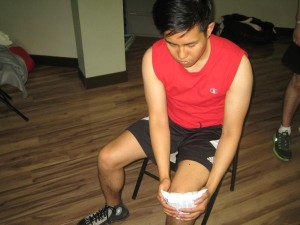A medial knee ligament injury involves injury to the ligament on the interior of the knee joint. This is often caused by twisting or an impact to the exterior part of the knee. It is important to note that medial knee ligament injuries are quite common in contact sports such as rugby and football as well as in martial arts. The injuries can also occur in daily life through falls and twists of the knee joint. Just like with ligament injuries, they are graded 1, 2 or 3 depending on the severity. If you want to properly manage this injury, read here.
Symptoms
The medial ligament is verified by utilizing the valgus stress test that places strain on the ligament by applying force on the outside of the knee, thus stretching out the ligament.
In case pain or excessive laxity is evident, it is possible that the medial ligament is also damaged.

- Grade 1 – there is mild tenderness on the interior of the knee over the ligament and there is no swelling. Once the knee is flexed to 30 degrees and an exterior force is placed to the interior leg to stress out the medial ligament, pain is experienced but joint laxity is absent.
- Grade 2 – there is significant tenderness on the interior of the knee on the medial ligament. There is minimal swelling over the ligament. Once the knee is stressed for grade 1 symptoms, it typically includes pain and mild to moderate slackness in the joint.
- Grade 3 – there is full tear of the ligament. The pain can vary and oftentimes not as severe as a grade 2 injury. When the knee is stressed, there is significant joint laxity and there is a wobbly or unstable knee.
Treatment for medial knee ligament injury
The initial treatment is the RICE method (rest, ice, compression, elevation) to the affected knee. The individual should rest from training and utilize a knee brace to support the affected joint, especially for grade 2 and 3 injuries. It is also recommended to use a heat retainer after the acute phase for minor injury. If possible, try to keep the knee mobile.
When to consult a doctor
In most cases, a plaster cast or support bandage is applied for full ruptures. The doctor will aspirate the joint to remove fluid using a needle. Sports massage techniques are also applied to help hasten the rehabilitation process. In some cases, laser treatment or ultrasound can be used.
A MRI scan will be required and there is the possibility for surgical reconstruction for cases involving severe ligament tears. A rehabilitation program is also started in order to maintain the strength and mobility of the leg muscle.
When it comes to medial knee ligament injuries, it should be taken seriously since they affect the balance and stability of the joint. If the proper functioning of these ligaments is disrupted, activities such as running over uneven terrain can be difficult with the possibility that the knee will give away. Nevertheless, with proper rehabilitation, full recovery can be achieved.
